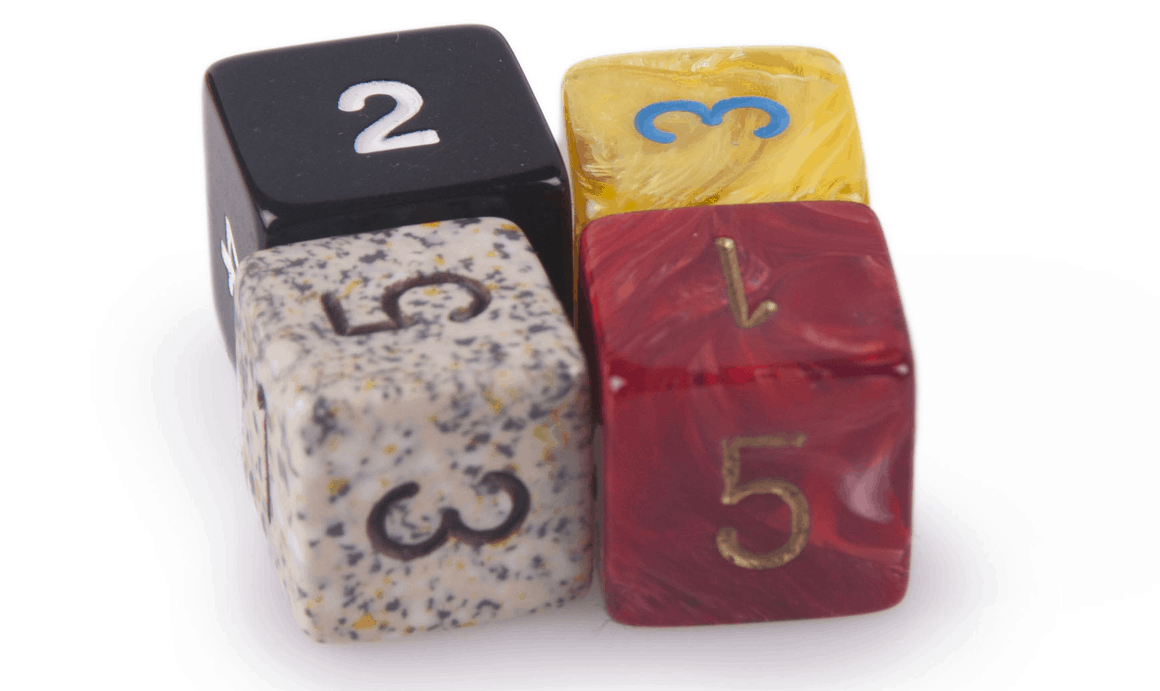
Standard Array is one of several methods to establish your character’s ability scores in Dungeons & Dragons 5E.
Standard Array’s ability scores are as follows: 15, 14, 13, 12, 10, 8. You can put these numbers in any ability you wish; strength, dexterity, constitution, intelligence, wisdom, and charisma. After placing your numbers where you want, add your race ability score increases, and you’re all ready to go.
What does the book say?
The bolded section applies to Standard Array.
Player’s Handbook, page 13.
You generate your character’s six Ability Scores randomly. Roll four 6-sided dice and record the total of the highest three dice on a piece of scratch paper. Do this five more times so that you have six numbers. If you want to save time or don’t like the idea of randomly determining ability scores, you can use the following scores instead: 15, 14, 13, 12, 10, 8.
Now take your six numbers and write each number beside one of your character’s six abilities to assign scores to Strength, Dexterity, Constitution, Intelligence, Wisdom, and Charisma. Afterward, make any changes to your Ability Scores as a result of your race choice.
Standard Array Step-by-Step.
Let’s say you are making a character for a new game, and your DM tells you that you will be using Standard Array for your ability scores.
You decide to play a fighter. I would assign these scores (15, 14, 13, 12, 10, 8) like this.
| Abilities | Score |
| Strength | 15 |
| Dexterity | 13 |
| Constitution | 14 |
| Intelligence | 10 |
| Wisdom | 12 |
| Charisma | 8 |
After this, you would add your race’s ability score increases for your true totals. For example, let’s say your Fighter is a half-orc. You would increase the strength by 2 and the constitution by 1, making your strength 17 and your constitution 15—all in all, a good start for a fighter.
Who is Standard Array best for?
Standard Array is great for new players. Dungeons & Dragons can be a little overwhelming with all its rules. Explaining how to either role for ability scores or use point buy can sometimes add to the confusion. This is where Standard Array can help expedite the process. If you are new to DMing or new to playing, this method will help you start playing as soon as possible.
The Advantage and Disadvantage to Standard Array.
The Advantage.
- Standard Array is easy for new players to understand and will help the character creation process move faster.
- It is fair. Sometimes, when rolling for ability scores, you may have a player role two 18s and have another player not get above a 15. Though this makes for interesting characters, some players consider it unfair.
The Disadvantage.
- Standard Array is not something I would suggest for experienced players. If you’re worried about being fair, go with the point buy system. However, if you want to have a bit of fun, let your players roll the traditional 4D6 and remove the lowest.
- Another problem with Standard Array and point buy is that you sometimes lose a bit of characterization for your players. It’s just fun to have a fighter with 3 intelligence or a wizard with a 4 strength.

Other Ways for Determining Your Ability Scores.
There are two other popular ways to determine your character’s ability scores. The point buy system and rolling. Both are good for experienced players and will work with new players if your DM chooses it.
The Point Buy System
The point buy system is great for experienced players. It allows a little more flexibility than Standard Array. With this system, players are given 27 points to spend on ability scores. However, I have played in campaigns where DM’s have allowed PC to use 32 points for more powerful characters.
One of the things I enjoy about this system is it keeps your less-than-honest players from fudging their dice rolls for ability scores. We all know who they are.
What does the book say?
Player’s Handbook, page 13.
At your Dungeon Master’s option, you can use this variant for determining your Ability Scores. The method described here allows you to build a character with a set of ability scores you choose individually.
You have 27 points to spend on your Ability Scores. The cost of each score is shown on the Ability Score Point Cost table. For example, a score of 14 costs 7 points. Using this method, 15 is the highest ability score you can end up with, before applying racial increases. You can’t have a score lower than 8.
This method of determining Ability Scores enables you to create a set of three high numbers and three low ones (15, 15, 15, 8, 8, 8), a set of numbers that are above average and nearly equal (13, 13, 13, 12, 12, 12), or any set of numbers between those extremes.
Ability Score Point Cost
| Score | Cost |
| 8 | 0 |
| 9 | 1 |
| 10 | 2 |
| 11 | 3 |
| 12 | 4 |
| 13 | 5 |
| 14 | 7 |
| 15 | 9 |
As you can see, it is simple. Use your points to buy your ability scores until you are out of points. After that, add your race’s ability score increases, and you’re ready to go.
Rolling Your Ability Scores
Rolling is the most popular method for determining ability scores. It is one of my favorites. Rolling is great for experienced players who know what to do with both good and bad rolls. You roll 4D6s and add the three highest dice for your total. For example, if I rolled my 4D6 and got a 5, 4, 6, and 2, I would remove the 2 and add the other three numbers together for a total of 16. Then I would do this five more times.
What does the book say?
Player’s Handbook, page 13.
You generate your character’s six Ability Scores randomly. Roll four 6-sided dice and record the total of the highest three dice on a piece of scratch paper. Do this five more times so that you have six numbers.
With Standard Array and point buy, the highest score you can get naturally is a 15. However, with rolling, the highest you can get is an 18. But with great reward comes risk. You could accompany that 18 with a 6 and a 3. This may seem like a bad thing, but I have seen some of the best characters ever, and some of the best moments, come into play because of bad ability rolls.

FAQ’s About Standard Array.
What is the standard array 5e?
Standard Array is an easier way to get started quickly in Dungeons & Dragons 5E. Instead of rolling for your ability scores or using the point buy system, you use set ability scores (15, 14, 13, 12, 10, 8), and place them wherever you would like.
Is Point buy or standard array better?
The point-buy system is better for more experienced players, and Standard Array is better for beginners. Both are good at keeping your PC’s characters fair. No single player will have high ability scores while another has lower ability scores. If you have experienced players and want to introduce a bit of randomness, use the traditional 4D6 and remove the lowest.
How do you do a standard array?
You assign these predetermined numbers (15, 14, 13, 12, 10, 8), one for each ability score. Then, add your racial ability score increases for your totals. This is great for beginners and an easy way to get started quickly.

Ultimately it does not matter how you choose to determine your ability scores; standard array, point buy, or rolling are all great methods. So don’t worry too much about it. Pick one and try it. And try something else next time. In the end, you’ll be playing Dungeons & Dragons, and it will be great.
There is no right or wrong way. There is only your imagination.

If you have enjoyed this “How It Works” article, check out this one on Two-Weapon Fighting.





Leave a Comment